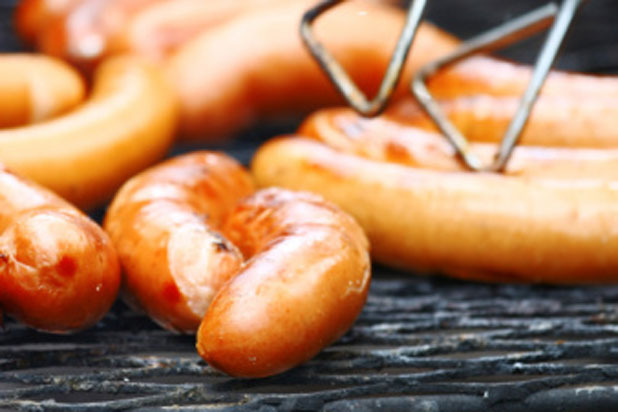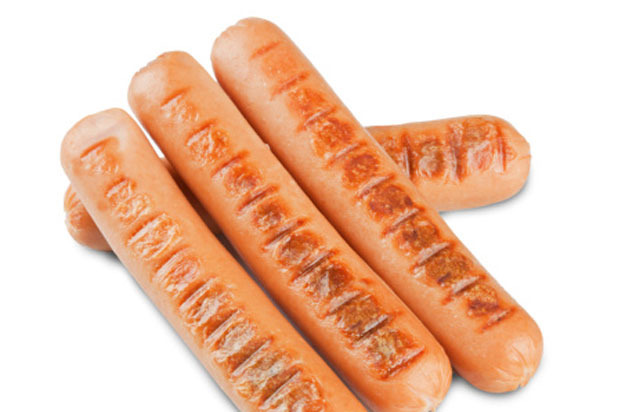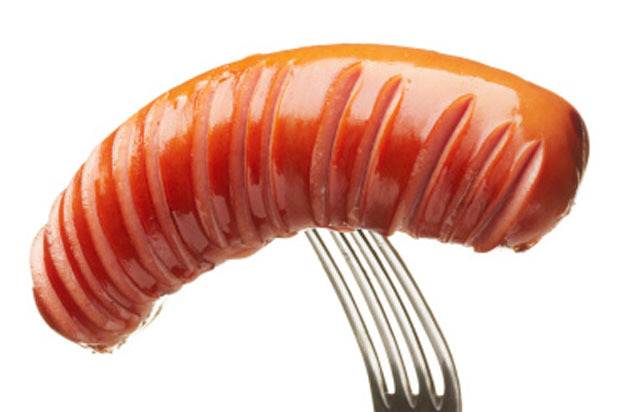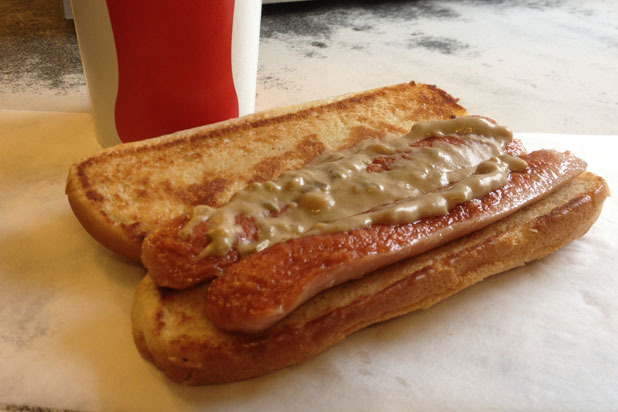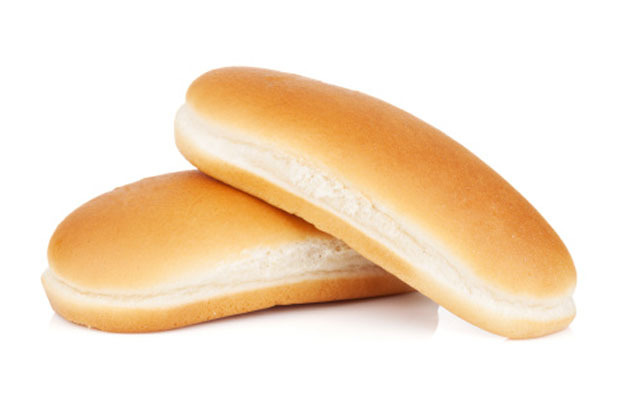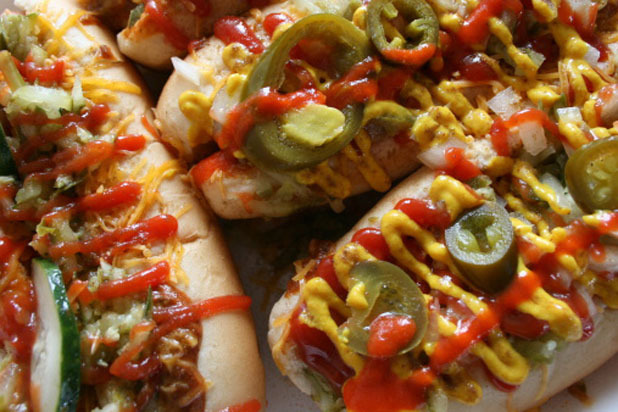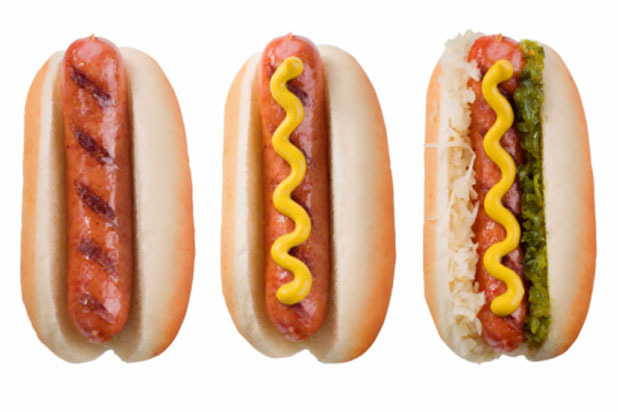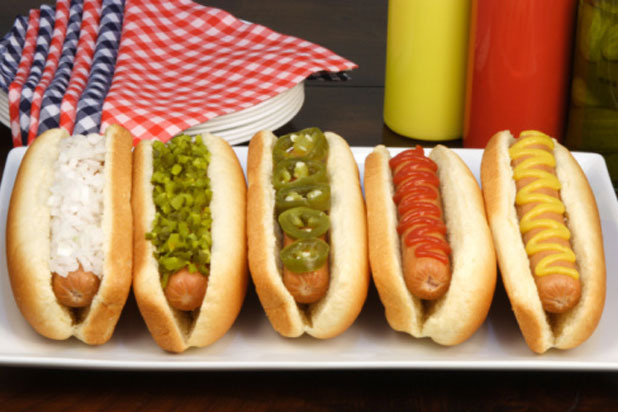How To Build The Perfect Hot Dog Slideshow
The first thing to consider when you're building a hot dog is the type of hot dog itself, which varies from meat blends to casing. Warrington's father chose to go with a blend of pork, beef, and veal, because he found that all beef was too soft. He knew what he wanted right from the start, no matter how many tries it took.
"My father, Walter, went down to a hot dog maker in [New York City] and told him exactly how he wanted them made, and kept telling him until he got it right. That's how a Walter's hot dog came to be. For 93 years, we've made it the same way."
Most blends of meat come with a standard natural casing of sheep's intestines, which is known for giving the dog its "snap" when you bite into it. Other hot dogs have no casings at all, which will produce a much softer dog to bite into, and some have casings that are dyed, like Maine's red snapper dogs. Choosing the type of dog you're going to work with all depends on personal preference, but it'll make a difference down the road when deciding on other elements, so it's good to have this decided first.
Step 2: Cooking the Dog
So you've decided what kind of dog you're going to make, but do you know how you're going to make it? There's several ways a dog can be prepared, whether it's grilling, griddling, deep-frying, or steaming, but before we get into that, we want to make sure it's prepped properly. The thing to keep in mind about cooking your dog is that the dogs are, for the most part, already cooked for us, so any method you choose is just to finish them off and impart flavor. A lot of hot dog experts like pre-seasoning their dogs by steeping them in a mixture of beer and brine before finishing them off on a hot grill or pan to give them texture. Others, like Warrington, baste their dogs in a "special sauce," while they're grilling them so that the flavor lingers even longer. Along with seasoning, there's the cut of the dog to consider, whether it be whole, scored down the middle, or split in half and opened like a book.
Whole Dogs
You'll most likely see dogs whole when they're wrapped in something (like bacon), deep-fried, or steamed.. You'll also hear people say that they leave their dogs whole because it conserves the flavor and moisture of the dog, while others don't feel as strongly. Keep in mind that when cooking a dog whole, it's more likely to burst out of its casing, so any method you choose should be a mild one, even if you're grilling them.
Scored Dogs
Giving a hot dog three small, shallow, and perpendicular cuts down the middle is known as scoring . This is to prevent the casing from bursting, as mentioned above, and is usually done when a large of amount of heat is applied to the dog, such as with grilling or pan frying. Along with preventing the casing from tearing, it also leaves small little pockets in the dog for the dressings to soak in, so a lot of people choose to do it for flavoring reasons.
Split Top Dogs
These dogs are the ones that are split all the way down the middle and opened like a book. A lot of people warn against splitting the dogs because it's takes away the moisture of the hot dog, but Warrington's father chose this method to be different, and finds that by frying them on a flat-top griddle, split side down with a few slits in each side, keeps them from curling and makes a perfectly cooked hot dog all the way through. Along with exposing more surface space to cook, the book-opened dog is a perfect bed for toppings and dressings to rest in, as well.
Step 3: The Bun
Once you've decided what kind of dog you're going to use and how you're going to prep and cook it, you're ready to consider the bun. One thing to remember when choosing a bun is that it should always be the same length as the dog, because both the hot dog and bun should be in every bite. Depending on how you cut your dog, and eventually how you top it, you'll want to consider the type of bun you're using; whether it's a New England split top bun or a regular hot dog bun that opens like a book, because certain ones will be better than others for holding your dog and its toppings in place. The last thing to consider is the texture. Are you grilling a typical dog with a snappy casing? Then you're probably going to want a little crunch to hold up to its charred snap, whereas a steamed, soft bun would be perfect for a steamed, soft dog. Lastly, most people, like Warrington and his father, choose a particular bun and how to prepare it simply because of the taste. If you like a nicely toasted, buttery roll, then you'll probably like your hot dog bun like that, as well.
Step 4: The Toppings
The toppings of a hot dog are what differentiate them regionally, so it's important to make your mark with yours, too. Walter's dogs come with a schmear of their special blend of mustard and relish, one that was carefully created in order to not outshine the dog.
"My father invented his own special blend of mustard with a whisper of relish in it. Customers used to ask for mustard with a bit of relish on the side, so he figured he'd make a mustard- relish combination. He wanted the customer to experience the full taste of the hot dog, and when you put too much on top, it takes away from the hot dog," Warrington told us.
Toppings, Contd.
The general rule of thumb for toppings is anything that gives a little heat, acidity, and sweetness works well with the hot dog and the bun. Texture is good to consider as well, so if you like a little crunch, diced onions and relish might be your go to, and if you like the alternate, you might just want melted cheese and chili. When topping your dog, consider not only the texture but the mouth feel as well. If you cringe at the thought of mustard and ketchup sinking into your gums with each bite, then dress the bun with them before placing the dog in it. And if you've chosen to make a whole dog rather than one split down the middle, consider placing all of the ingredients in the bun first, and then drizzling the hot dog with condiments on top, so that the ingredients stay in place and are in each and every bite.
Closing Thoughts
So you see, there's a lot that goes into the beautiful simplicity of a hot dog, and we hope that by walking you through each step, you'll be ready to create a hot dog of your own. If you're looking for even more inspiration, check out our picks for America's 35 best and our round up of unique toppings from all around the world.

